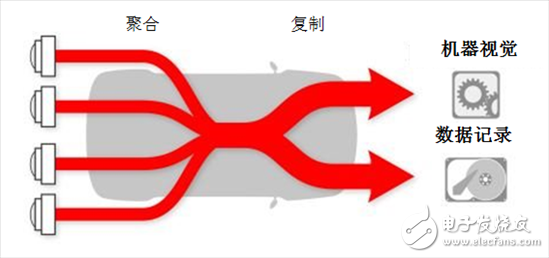How to use the MIPI® CSI-2 port to copy and record sensor data in an ADAS application
As advanced driver assistance systems (ADAS) contribute to autonomous driving, there is an increasing demand for multiple copies of aggregated video sensor data for machine vision, viewing, parallel processing, and data logging.
Front-facing machine vision cameras require multiple copies, but it will soon be suitable for other cameras, radar and light detection and ranging (LIDAR) sensors in autonomous vehicles. Data logging is a very common replication application today (Figure 1). In machine vision applications, raw sensor data for certain driving events is typically recorded for future analysis. In this case, it is useful to use the second copy of the aggregated raw sensor data for data logging; the other copy is used for machine vision processing.

Figure 1: Common ADAS data record topology
Copy aggregated sensor data
Data replication is possible at different locations in the video path. Each sensor can be connected to the machine vision and data logging electronic control unit (ECU) via a separate cable, but this way doubles the number of cables required. Conversely, splitting data after sensor data aggregation typically becomes simpler. For example, the DS90UB964-Q1 Quad Deserializer Hub aggregates raw data for up to four different sensors and creates two combined data copies without the need for external components such as splitters and bridge chips. Machine vision algorithms (such as object recognition) can process one stream while another stream is recorded to the data record memory (Figure 2). The connected sensors need not all be the same; combining multiple sensors of different types, resolutions and speeds enables a true sensor fusion system. For example, you can combine camera combinations at different frame rates with data from individual radar sensors.

Figure 2: Port replication mode is useful for replicating aggregated sensor data streams for machine vision processing and data logging operations
Figure 3 shows a four camera system with different data rates as indicated by the colored blocks. Aggregated data is presented at the Mobile Industrial Processor Interface (MIPI) Camera Serial Interface (CSI)-2 ports 0 and 1. The CSI-2 bus is "bursty", meaning that it operates at a fixed data rate, sends data in an available state, and returns to a low power (LP) state when idle. Therefore, the sensor speed can be changed without changing the timing of the ECU processor. Even though the sensor chain operates at an independent frequency, the deserializer hub provides data to a system on a chip (SoC) processor on a single reference clock, simplifying system timing.

Figure 3: The DS90UB964-Q1 aggregates and replicates four different types of sensors to two MIPI CSI-2 ports
The DS90UB964-Q1 supports MIPI CSI-2 virtual channel ID remapping. The virtual channel separates the sensor data in the aggregated stream so that the processor can easily determine which sensor each packet came from without having to count the bits in the bit stuffing method. The processor simply reads the virtual ID (VC-ID) field in the data header to determine the virtual channel address. If the sensors already use the same VC-ID, they can be remapped to unused VC-IDs to distinguish the input data. With up to 1.6Gbps / channel, a total of 6.4Gbps bandwidth per port can be used to support 4 + 1MP / 60fps, 2MP / 30fps or satellite radar sensors - or a combination of different sensors.
in conclusion
Data logging will play an increasingly important role in ADAS, especially in autonomous driving applications. Once the sensor data has been aggregated, copying the sensor data is usually most effective. The new product integrates replication capabilities without the need for an external splitter, creating new architectural possibilities for future automotive ADAS applications. To learn more about ADAS cameras and radar applications, please log in and leave a comment or browse.
other information
Check out the industry's first dual-port MIPI CSI-2 four-channel deserializer hub with replication mode .
To get started quickly, download TI Designs "Automotive ADAS 4 Camera Hub Reference Design with Integrated ISP and DVP Output."
Pair our deserializer hub with the TDA3x SoC processor for ADAS .
Multi device Wireless Bluetooth Keyboard and mouse combo offers 2.4G and 2 Bluetooth (5.0+3.0) channels and, enable you to connect up to 3 devices at the same time, and easily switch them by pressing 2.4G/Bluetooth 1/Bluetooth 2 button, saving money and working space. You can also switch back and forth between 3 devices at will. The switch button is in the upper right corner of the keyboard, which is convenient and quick.
Wireless keyboard and mouse set can be connected to many kinds of devices and is well compatible with your iPad, tablet, phone, computer, laptop (Windows / Mac OS / IOS / Android etc.The keyboard and mouse combo also has an automatic power saving function design. Even if you forget to turn off the switch, they can automatically enter sleep mode to save power. You can wake them up by clicking any button.
Bluetooth Keyboard Combo,Wireless Keyboard And Mouse,Wireless Keyboard Mouse,Bluetooth Keyboard And Mouse Combo
Dongguan Jupu Electronic Co.,Ltd , https://www.jupumade.com